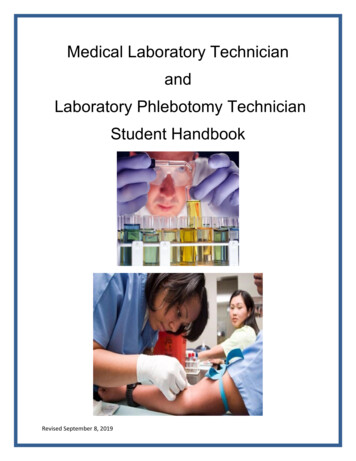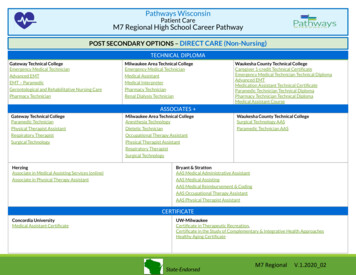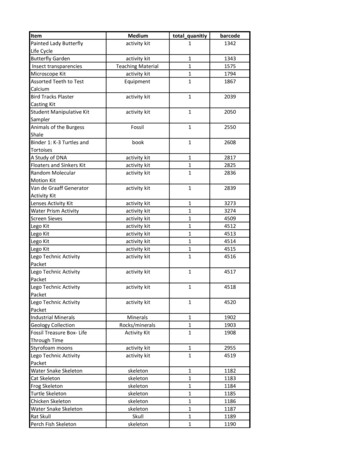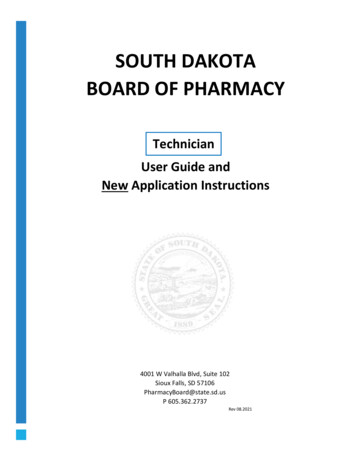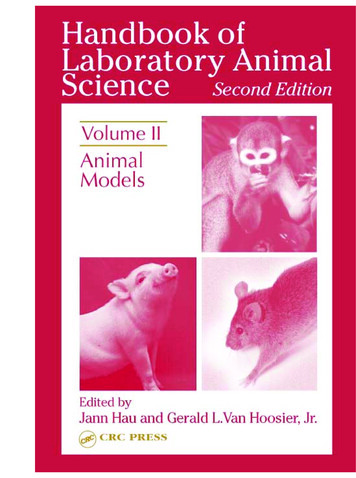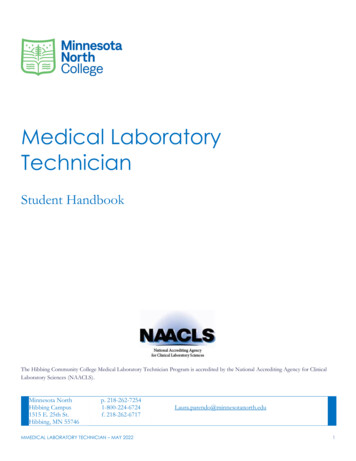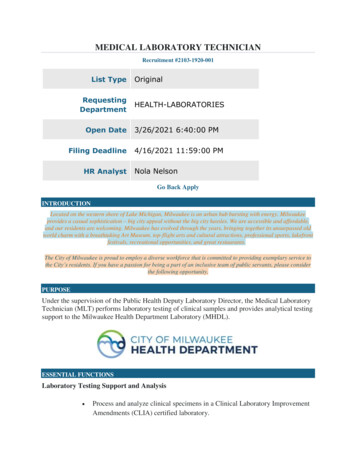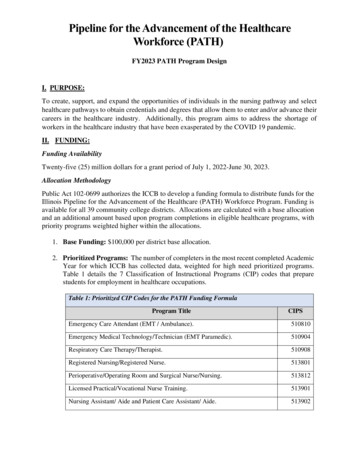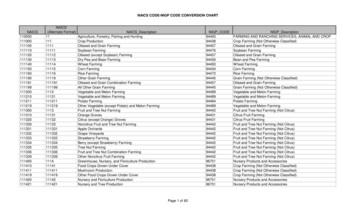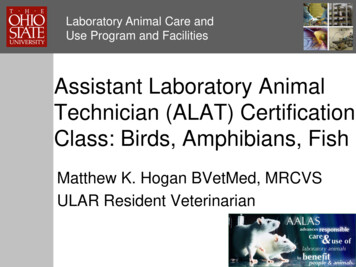
Transcription
Laboratory Animal Care andUse Program and FacilitiesAssistant Laboratory AnimalTechnician (ALAT) CertificationClass: Birds, Amphibians, FishMatthew K. Hogan BVetMed, MRCVSULAR Resident Veterinarian
Agenda ALAT Training Manual– Chapter 29-Birds– Chapter 30-Amphibians– Chapter 31-FishLaboratory Animal Care and Use Program and Facilities
BirdsLaboratory Animal Care and Use Program and Facilities
Uses in Research logyEmbryologyLaboratory Animal Care and Use Program and Facilities NOT covered under AWA ifbred for research COVERED under PHSpolicy GUIDELINES for care in theGuide and Ag Guide
Taxonomy: Aves Order: Galliformes– Poultry Turkey Chicken (Gallusgallus domesticus)– Robust immunity– Eggs used in Abproduction fluvaccines QuailLaboratory Animal Care and Use Program and Facilities
Taxonomy: Aves Order: Columbiformes– Pigeon White Carneau(Columba livia)– Atherosclerosis– Learning & memory– DoveLaboratory Animal Care and Use Program and Facilities
Taxonomy: Aves Order: Passeriformes– Common name: passerines SparrowCrowCanaryFinch– Zebrafinches (Taeniopygia guttata)» Learning, memory, language developmentmodels (songs)Laboratory Animal Care and Use Program and Facilities
Taxonomy: Aves Order: Psittaciformes– Common name: psittacines Parrots Parakeets/budgies CockatoosLaboratory Animal Care and Use Program and Facilities
Physical Characteristics Adapted for flight– Forelimbs wings– Fused & hollow bones strength, lightness Lightness fragility injury during handlingLaboratory Animal Care and Use Program and Facilities
Unique Biological & PhysicalFeatures Spur– Male galliformes nail notassociated with a toe– On lower limbs, points towardsthe tail– Fighting, defense, aggression Can trim, remove High body temperature (e.g.chicken 107oF) No sweat glands thermoregulation via pantingLaboratory Animal Care and Use Program and Facilities
Feathers Feature not shared with anyother vertebrate Functions:– Flight– Insulation– Water-proofing preen/uropygial gland Molting 1/year– Can occur due to stress,improper lighting, poor nutritionLaboratory Animal Care and Use Program and Facilities
Digestive Anatomy Crop– Expansible esophageal outpouching– Stores food– Crop milk protein, fat, Ab rich material for hatchlings Gizzard– Grinds up food (seeds) Cloaca– One chamber for intestinal, urinary and reproductivecontents/material to empty– Female lay eggs; male evaginates to pass sperm Waste– Thick-white pasty urine– Green-brown fecesLaboratory Animal Care and Use Program and Facilities
Laboratory Animal Care and Use Program and Facilities
Sexing Sexual dimorphism– Size– Feather conformation– Color pattern Other indicators– Color change (male)– Cloacal change– Featherless breast (female)Laboratory Animal Care and Use Program and Facilities
Sexing Surgical inspection/PME– Internal gonads Female– Left side only functional Male– No accessory sex organs or true penisLaboratory Animal Care and Use Program and Facilities
SexingFemaleLaboratory Animal Care and Use Program and FacilitiesMale
Handling Birds are easily alarmed or frightened injury (fly into wall, trampling), overheating Calm, cool, correct handling imperative– Move slowly and deliberatly– Handle, change cages, manipulate in dimlighting calming state– Attempt capture once, if fail, give extendedbreak before attempting againLaboratory Animal Care and Use Program and Facilities
Handling Galliformes Chickens– Can carry upside down by legs– Restrain wings & legs with hands, tuckunder arm for support (pic)– Add’n aids: tape legs together, drapecloth over head/eyes calm Turkeys– DO NOT carry by legs– Stronger, more aggressive thanchickens– One hand encircles humerus of bothwings over back, restrain head withfingers around neck, hold legs withother handLaboratory Animal Care and Use Program and Facilities
Handling Columbiformes &Passerines Small, swift difficulty insafe capturing Nets, small cage hands Can restrain largepigeon/dove like chicken(pic) Parrots/parakeets:– Restrain head to avoid bites( /- gloves); cover head– Stockinette: wings restrained,head & tail exposedLaboratory Animal Care and Use Program and Facilities
Identification Leg bands– Color-coated and/oralphanumeric– Radiofrequency ID chip(larger birds)– Size & place consideredalong with growth of bird– Checked as part of bird healthexam Wing tags DyesLaboratory Animal Care and Use Program and Facilities
Behavior Easily excited– Respond to sudden noise & movements withvocalizations calm, quiet handling Groups can have strict hierarchy fighting, food possession– Nail trims– Restrict flight Pinioning? Surgical removal of distal tip of wing Wing clip 1st 10 primary feathers; one wing!– Beak mgmt cuttle boneLaboratory Animal Care and Use Program and Facilities
Housing AWA does not address birds Physical Environment– Prevent exposure to wild birds/rodents– Perches – variable size– Adequate space for freely flapping wings Psychological well being– Solid panels between cages if conflicts Environmental– Humidity 45 – 70%– Lighting Wide spectrum or incandescent should be used– Temperature Ventilation important, susceptible to heat stressLaboratory Animal Care and Use Program and Facilities
Housing Guide (poultry):– Air temperature: 16-27oC (61-81oF)– Relative humidity: 30-70% Cage litter:– Species dependent– Cover floor with sand, gravel or shavings– Place low plexiglass frame around perimeter to containlitter Design– Flexibility accommodate other species, group sizes– Avoid mixing species, variable age groups– Away from swine/dogs (noise) & shield from visualdisturbances– Have external heat source/brooder for very young birdsLaboratory Animal Care and Use Program and Facilities
Diet Water– Suspended automatic watering system Feed is species dependent– Commercial formulated pellets– Passeriformes: seeds (canary grass) vegetables,fruits, cooked egg yolks– Psittacines: seeds (sunflower, canary grass) peanuts,monkey biscuits Grit– Necessary, remains in gizzard aids in grinding ofseeds during digestion– Includes oyster shells and granite (autoclave/sterilize) Cuttlebone (passerines & psittacines) beakmaintenance CalciumLaboratory Animal Care and Use Program and Facilities
Husbandry Feed & water containers– Several locations at varying heights reduced aggression– Scatter feed on floor dish to adapt birdto bowl feeding Environmental enrichment– Music– Colored objects/toys– Nesting materialLaboratory Animal Care and Use Program and Facilities
EuthanasiaMethodAcceptableAcceptable w/conditionsAvianIV barbiturates Inhaled anesthetics, CO2,CO, N2, Ar, cervicaldislocation (small birds andpoultry), decapitation(small birds)PoultryInjectedbarbituratesand anestheticoverdoseLaboratory Animal Care and Use Program and FacilitiesCO2, CO, N2, Ar, cervicaldislocation (asanatomically appropriate),decapitation, manual bluntforce trauma, electrocution,gunshot, captive bolt
AmphibiansLaboratory Animal Care and Use Program and Facilities
Amphibians Vertebrates– Scaleless, smooth-skinned, ectothermic– Need aquatic or very moistenvironments– Most begin life as gill-breathing larvae(tadpole) metamorphosisLaboratory Animal Care and Use Program and Facilities
Common Species inResearch Frogs– Bullfrog (Rana catesbeiana) Physiology and acoustics Motion sickness in spacetravel– They can vomit!!!– Leopard frog(Rana pipiens) Hormone studiesLaboratory Animal Care and Use Program and Facilities
Common Species inResearch Frogs– African-clawed frog(Xenopus) Entirely Aquatic Originally used inpregnancy assays Developmental studies year roundreproduction withhormone therapy Genetics & molecularbiology oocytesLaboratory Animal Care and Use Program and FacilitiesX. laevisX. tropicalis
Besides frogs! Tiger Salamander (Ambystomatigrinum)– Ophthalmology– Limb regeneration Red Spotted Newt(Notophthalmus viridescens)– Limb and lens regeneration Axolotl (Ambystomamexicanum)– Limb regenerationLaboratory Animal Care and Use Program and Facilities
AnatomyLaboratory Animal Care and Use Program and Facilities
Skin Absorb O2 through moist skin breathing!– Have lungs, no diaphragm Larve breath via gills– Chemicals can permeate skin too Mucous Glands– Slimy protective layer Granular Glands– Head & shoulders– Compounds & chemicals Defense compounds (neurotoxins, hallucinogenics) Magainins (inhibit growth of pathogens) PheromonesLaboratory Animal Care and Use Program and Facilities
Digestion & Excretion Adults:– Carnivores w/short GIT welldeveloped tongue Xenopus no tongue, use front limbs tofeed– Cloaca (like birds!)Laboratory Animal Care and Use Program and Facilities
Sexing Xenopus:– F M (female is pear-shaped)– Male has roughened blacknuptial pads & large thumbs General:– Tympanic membrane 2x larger inmales (bullfrogs)– Species specific matingbehaviorsLaboratory Animal Care and Use Program and Facilities
Tympanic MembraneLaboratory Animal Care and Use Program and Facilities
Mating Induce ovulation in female &stimulate sexual activity in male withhormone injections Egg collection:– Collect before adults eat them– Can collect unfertilized eggs Manual expression SurgeryLaboratory Animal Care and Use Program and Facilities
Development Metamorphosis Neoteny– Retain larval characteristics throughoutlifeLaboratory Animal Care and Use Program and Facilities
Handling & Restraint Only handle when necessary Handle w/moist, powder-free gloves– Nets or jars– Eye protection: cane toads toxic skinsecretions from parotid gland Restraint:– Salamander: grasp head and forelimbsw/one hand, hindlimbs w/other (neverhold by tail!)– Axolotl: never use net!Laboratory Animal Care and Use Program and Facilities
Frog RestraintLaboratory Animal Care and Use Program and Facilities
Identification Cage card may be sufficient Individual ID:–––––Photographs of skin patternsTattoo (fades as skin sheds)Toe-clipping (discouraged; IACUC approval)Freezing (branding-method)PIT passive integrated transponders(microchips)Laboratory Animal Care and Use Program and Facilities
Behavior Cannibalism– Adults may eat eggs, tadpoles, growingadults due to overcrowding, poor diet Sensitivity– Environmental temperature (ectothermic)– Overhandling, too much enrichment– Skin water quality key! Pain, distress, illness– Lethargic, poor appetite– Bacterial infection: ‘red leg’– Parasitic infection: thick, pitted, sloughing ofskinLaboratory Animal Care and Use Program and Facilities
Housing Temperature– Tropical species – 21‐29oC (70‐85oF)– Temperate – 18‐22oC (65‐72oF) High humidity: 80% need moisture Lighting– Full wavelength spectrum Reduce airflow to prevent habitat &animal desiccationLaboratory Animal Care and Use Program and Facilities
Housing: Aquatic SystemsSystemFeaturesStatic No recirculation of tank waterWater change by draining & refillingClean frequently due to waste accumulationReplace old water with same temperature newwaterRecirculating Filters remove waste & debris Less frequent cleaning, but must replace filtersregularlyFlow-through Constants stream of water in and out of tank Fresh water is always available, but must makesure chlorine is reliably removed from thisincoming waterLaboratory Animal Care and Use Program and Facilities
Caging Terrestrial– Moist, misty environment Semi-aquatic– Sloping floor Hiding places– Bark– PVC piping– Pads– Dark-colored cagingLaboratory Animal Care and Use Program and Facilities
Water Quality Monitor & adjust:– Water hardness– Dissolved CO2 level– O2 level Bubbling filtered air through water:– Maintains correct concentration of dissolvedgases Keep light if new hatchlings present No detergents or disinfectants for cleaning– Remnants can be absorbed– Heat sterilization & scrubbing recommendedLaboratory Animal Care and Use Program and Facilities
Nutrition Adults: Carnivores– Commercial frozen gel/pellet (Xenopus) crickets, mealworms, brine (Salamanderexception)– Axolotls: beef muscle/organs vitamins– Daily‐twice weekly (species & life-stagedependent)– Larval salamanders: Carnivores Larval amphibians– Tadpoles: Herbivores– Spinach, yeast, lettuceLaboratory Animal Care and Use Program and Facilities
Euthanasia Varies per speciesAcceptableInjected barbiturates,dissociative agents andanesthetics asspecified, topical bufferedtricaine methanesulfonate(MS-222)or benzocainehydrochlorideLaboratory Animal Care and Use Program and FacilitiesAcceptable w/conditionsInhaled anesthetics asspecified, CO2, penetratingcaptive bolt or firearm,manually applied bluntforce trauma to the head,rapid freezing
FishLaboratory Animal Care and Use Program and Facilities
Uses of Fish in Research Models:– Endocrinology– Bacterial diseases– Genetics Conditions in human development– Toxicity studies– Health & husbandry of fish themselves Importance of fish in aquaculture Fish as a source of foodLaboratory Animal Care and Use Program and Facilities
Taxonomy Zebrafish– Danio rerio– Model for genetic conditions in humandevelopment and metabolism e.g. scoliosis Salmon & trout– Onchorhychus Catfish– IctalurusLaboratory Animal Care and Use Program and Facilities
General Considerations Fish are typical vertebrates in manyrespects (500 million years old)– One can apply basic concepts youalready know regarding mammalianbiology Possess the same/similar organsystems as in other animals– Have some unique anatomical andphysical characteristicsLaboratory Animal Care and Use Program and Facilities
Anatomy & Physiology Most fish have laterally compressed,elongated muscular bodies– Ectotherms– Fins for locomotion– Gills O2 exchange Operculum: flexible bony plate that covers/protectsgills– Lateral line: sense organ along each side offish detects movements/vibrations– Swim bladder: maintain buoyancyLaboratory Animal Care and Use Program and Facilities
Anatomy: Skin Mucus layer– Protects against infection– Waterproof skin Scales 2 sets of paired fins and 1 or 2 dorsal fins,anal & tail finLaboratory Animal Care and Use Program and Facilities
Anatomy & PhysiologyLaboratory Animal Care and Use Program and Facilities
Anatomy & PhysiologyLaboratory Animal Care and Use Program and Facilities
Sexing & Reproduction Most lay eggs, some bear living young– Over 97% fish lay eggs & fertilization takesplace outside the body– Fertilization may occur internally or externally Sperm released over eggs after female has laid them– Variable parental care: abandon or nest Live-bearing– Female male; Male more brightly colored Egg-layers– Female has swollen abdomen when ready tospawnLaboratory Animal Care and Use Program and Facilities
SexingLaboratory Animal Care and Use Program and Facilities
Question?!?1. What is spawning?a. The metamorphosis of a fish from eggto hatchling to adultb. Nest building behavior in fishc. The release of egg & sperm from C.female & male fishesd. The reinvention of Al Simmons akaSpawnLaboratory Animal Care and Use Program and Facilities
Zebrafish Breeding Either:– 10 gallon ‘breeding tank’: lots of males &females together– Small tank with 1 or 2m:2f Breeding tanks have perforation to keepadults from eating eggs 1/week: place fish in breeding tank late inday collect eggs next morning & returnadults to home tanks Keep embryos at 24-33oC; will feed onown 4-6d post-fertilizationLaboratory Animal Care and Use Program and Facilities
Procurement Usually shipped in plastic bags/foamcontainers– Bags must have an air pocket Minimize shipping time as much aspossible Temperature adjust transport water to tank– Can also add tank water to shipping water Should unpack immediately upon arrival Ideally, all incoming fish should bequarantined for 30d– Usually only embryos go to primary systemLaboratory Animal Care and Use Program and Facilities
Handling, Restraint,Identification Handling and Restraint– Fish NEVER acclimate to being handled Can anesthetize if needed Wear wet, non‐powdered gloves ( /- fullarm length) Identification Methods– Records can be kept at tank level or peranimal– SQ dye, tags, fin clipping, SQ orabdominal transpondersLaboratory Animal Care and Use Program and Facilities
Pain, Distress, Illness Signs––––––––ListlessnessChange in feedingErratic movements/flashingIsolation; staying near bottom/topof tankGulping air at surfaceLoss of buoyancyClamped fins, operculum flaringLesions/altered skin/scalesLaboratory Animal Care and Use Program and Facilities
Facilities Waterproof surfaces 1 gallon 3.78kg (8.33lb) Tanks should have dedicatedequipment– Disinfected and rinsed between uses Drainage (normal usage andspills) Electrical– Overhead supply or high on wall– Emergency powerLaboratory Animal Care and Use Program and Facilities
Facilities: Holding Systems Closed– “Static” fishbowl Flow‐through– Fresh water enters & passes through system Recirculating– Like flow‐through, but water is reused after being filteredLaboratory Animal Care and Use Program and Facilities
Water Quality pH– Varies with species; Ideal pH 6‐8 Water and room temperature– Adjustments should be gradual, nomore than 1oC per hour Specific gravity, conductivity, salinity– Salts and minerals in water, removed byreverse osmosisLaboratory Animal Care and Use Program and Facilities
Water Quality Hardness– Calcium and magnesium in the water Dissolved oxygen– Fish need to breath; decr as temperature incr Nitrogenous waste– Ammonia, nitrite, and nitrate– Removed by biofilter Lighting– Most fish require a low light level for growth &development, also limits algae growthLaboratory Animal Care and Use Program and Facilities
Husbandry Cleaning tanks:– NO disinfectants or detergents;residue health problems– NO leftover feed, feces, saltdeposits– Autoclave: kills algae & sanitizes DON’T autoclave biofilter kill goodbacteria Room cleaning– Disinfect between studies– Use disinfectant according to SOP(e.g. bleach)Laboratory Animal Care and Use Program and Facilities
Nutrition Quantity– Typical amount eaten in 3‐5 minutes– Excess source of nitrogen waste! Natural ingredient lab diet(commercial) Live food– Artemia, rotifers, Paramecium Schedule– Zebrafish 2x a dayLaboratory Animal Care and Use Program and Facilities
EuthanasiaMethodFinfishAcceptableAcceptable w/conditionsImmersion in bufferedbenzocaine orbenzocainehydrochloride, isoflurane,sevoflurane, quinaldinesulfate, buffered tricainemethanesulfonate (MS222), 2-phenoxyethanol,injected pentobarbital,rapid nol, isoeugenol, cloveoil, CO2-saturatedwater ervicaltransection/manuallyappliedblunt force trauma followedby pithing, rapid chillingfollowed by adjunctivemethod (aquarium-fishfacilities), maceration(research setting)Laboratory Animal Care and Use Program and Facilities
Questions?Happy Holidays & Happy NewYear !!!Laboratory Animal Care and Use Program and Facilities
Laboratory Animal Care and Use Program and Facilities . Feathers Feature not shared with any other vertebrate Functions: - Flight - Insulation - Water-proofing preen/uropygial gland Molting 1/year - Can occur due to stress, improper lighting, poor nutrition
